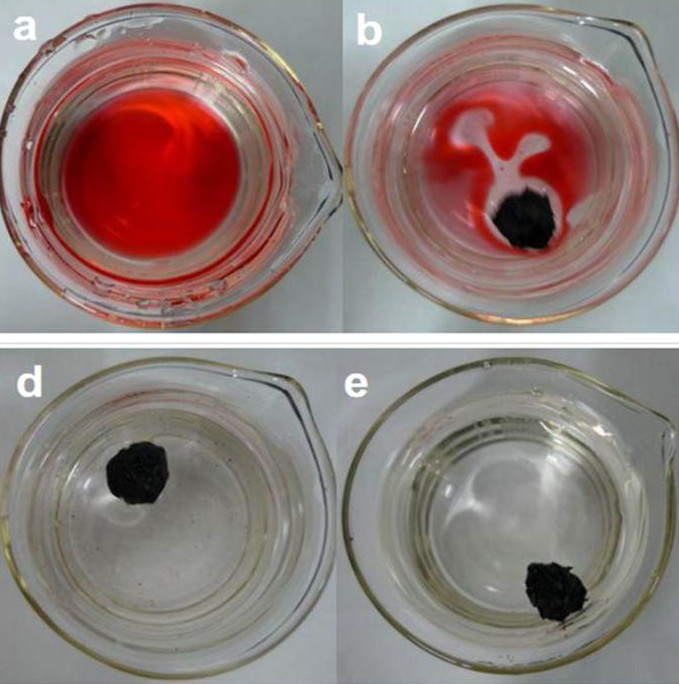Home > Press > Cleaning up oil spills with graphene sponges
 |
| Absorption of dodecane marked with red dye from artificial seawater using the graphene sponge. The absorption process was complete in 80 seconds. |
Abstract:
Since the discovery and isolation of graphene, physical scientists have been fascinated by the unique physics displayed by the truly two dimensional material, and materials scientists have been scrambling to harness these unique properties to develop its use in one or more "killer applications". Graphene has been proposed for a multitude of high-tech applications, including transparent conductors, fillers for polymeric composites, and electronic heat sinks, to take advantage of its exceptional electrical, mechanical, and thermal properties (for example). However, according to recent results by Professor Rodney Ruoff and co-workers, another more crude application may beat them all to the marketplace: oil spill cleanup.
Cleaning up oil spills with graphene sponges
Germany | Posted on August 10th, 2012Many different types of materials have been proposed or tested for use in cleaning up oil spills, including zeolites, polymers, activated carbon, and even sawdust. Selective absorption capacity of the oil layer is of paramount importance in such an application, and the toxicity of the absorbent itself is also an important consideration.
In Ruoff's work, a sponge-like graphene structure was fabricated by reducing graphene oxide and then applying a hydrothermal molding procedure in order to achieve a morphology with a high surface area. The researchers then tested the absorbance properties of this material for removing various commercial petroleum products (including kerosene, pump oil, fats, and organic solvents) from artificial seawater.
The remarkable results showed that the graphene sponge absorbed up to 86 times its weight, which was higher than all other common absorbents. The absorbed hydrocarbons were then subsequently recovered from the sponge with a 99% yield using simple heating. Using this procedure, the graphene sponge could then be regenerated and reused up to 10 times without a drop in performance. These exciting results could mean new hope in the unfortunate case of an environmental oil spill, but this type of technology could also be applied in more routine wastewater treatment applications or with industrial separations. The high-tech applications of graphene will come, but, with continued development in this direction, graphene's first "killer application" may not be high-tech at all.
####
For more information, please click here
Copyright © Wiley-VCH Materials Science Journals
If you have a comment, please Contact us.Issuers of news releases, not 7th Wave, Inc. or Nanotechnology Now, are solely responsible for the accuracy of the content.
| Related Links |
![]() Link to the original paper on Wiley Online Library
Link to the original paper on Wiley Online Library
| Related News Press |
News and information
![]() Researchers develop molecular qubits that communicate at telecom frequencies October 3rd, 2025
Researchers develop molecular qubits that communicate at telecom frequencies October 3rd, 2025
![]() Next-generation quantum communication October 3rd, 2025
Next-generation quantum communication October 3rd, 2025
![]() "Nanoreactor" cage uses visible light for catalytic and ultra-selective cross-cycloadditions October 3rd, 2025
"Nanoreactor" cage uses visible light for catalytic and ultra-selective cross-cycloadditions October 3rd, 2025
Graphene/ Graphite
![]() Electrifying results shed light on graphene foam as a potential material for lab grown cartilage June 6th, 2025
Electrifying results shed light on graphene foam as a potential material for lab grown cartilage June 6th, 2025
![]() Breakthrough in proton barrier films using pore-free graphene oxide: Kumamoto University researchers achieve new milestone in advanced coating technologies September 13th, 2024
Breakthrough in proton barrier films using pore-free graphene oxide: Kumamoto University researchers achieve new milestone in advanced coating technologies September 13th, 2024
Discoveries
![]() Researchers develop molecular qubits that communicate at telecom frequencies October 3rd, 2025
Researchers develop molecular qubits that communicate at telecom frequencies October 3rd, 2025
![]() Next-generation quantum communication October 3rd, 2025
Next-generation quantum communication October 3rd, 2025
![]() "Nanoreactor" cage uses visible light for catalytic and ultra-selective cross-cycloadditions October 3rd, 2025
"Nanoreactor" cage uses visible light for catalytic and ultra-selective cross-cycloadditions October 3rd, 2025
Announcements
![]() Rice membrane extracts lithium from brines with greater speed, less waste October 3rd, 2025
Rice membrane extracts lithium from brines with greater speed, less waste October 3rd, 2025
![]() Researchers develop molecular qubits that communicate at telecom frequencies October 3rd, 2025
Researchers develop molecular qubits that communicate at telecom frequencies October 3rd, 2025
![]() Next-generation quantum communication October 3rd, 2025
Next-generation quantum communication October 3rd, 2025
![]() "Nanoreactor" cage uses visible light for catalytic and ultra-selective cross-cycloadditions October 3rd, 2025
"Nanoreactor" cage uses visible light for catalytic and ultra-selective cross-cycloadditions October 3rd, 2025
Environment
![]() Researchers unveil a groundbreaking clay-based solution to capture carbon dioxide and combat climate change June 6th, 2025
Researchers unveil a groundbreaking clay-based solution to capture carbon dioxide and combat climate change June 6th, 2025
![]() Onion-like nanoparticles found in aircraft exhaust May 14th, 2025
Onion-like nanoparticles found in aircraft exhaust May 14th, 2025
![]() SMART researchers pioneer first-of-its-kind nanosensor for real-time iron detection in plants February 28th, 2025
SMART researchers pioneer first-of-its-kind nanosensor for real-time iron detection in plants February 28th, 2025
|
|
||
|
|
||
| The latest news from around the world, FREE | ||
|
|
||
|
|
||
| Premium Products | ||
|
|
||
|
Only the news you want to read!
Learn More |
||
|
|
||
|
Full-service, expert consulting
Learn More |
||
|
|
||








